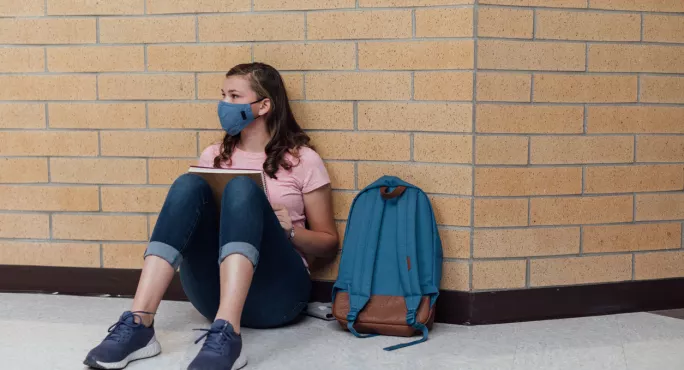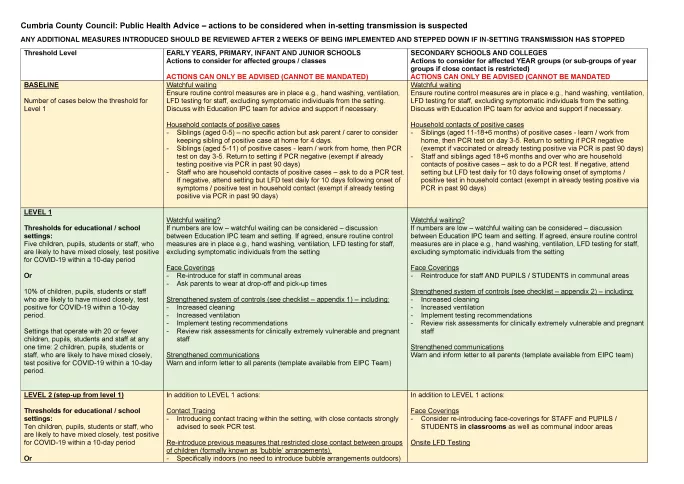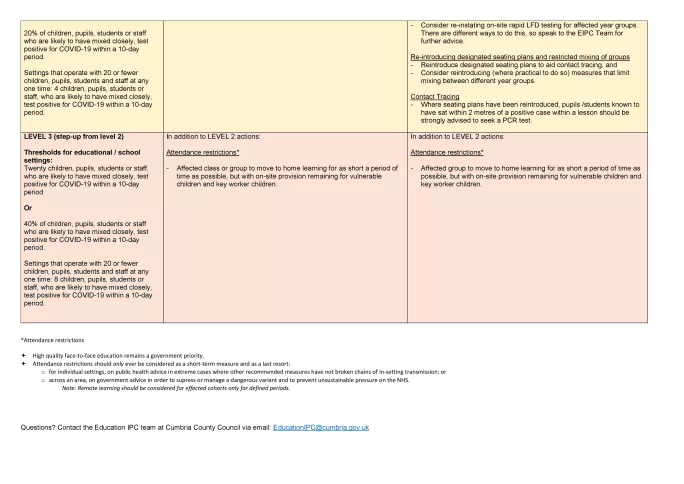
Fears school closures ‘inevitable’ as pupil cases soar

When Nadhim Zahawi took on the role of education secretary last month, he had a clear message for the sector.
“We can’t and won’t stand back and let attendance fall. The education of our children is simply too important,” he wrote.
It was hoped that the new academic year would mark something of a fresh start for schools, following the havoc the pandemic had wreaked on children’s education for the best part of 18 months.
Warning: DfE told to prepare for high Covid rates in schools
Hotspots: Covid rates ‘soaring’ where schools returned earlier
New term: Schools ‘could keep masks and social distancing’
Indeed, when pupils returned to the classroom for the autumn term, former education secretary Gavin Williamson said it marked the point when “our focus can shift away from the disruption of Covid and on to learning, enrichment and recovery”.
But with Covid cases now soaring in parts of the North and the Midlands, fears are creeping in that relaxing safety measures in an attempt to move past the crisis could put school closures on the horizon once again.
Research by Tes has revealed the stark reality of the situation on the ground just one month into the new academic year, with many schools forced to bring back certain precautions to curb sky-high local rates.
From a return to masks in corridors to stricter isolation rules, it is clear that, in many areas, things are far from back to normal.
How Covid is affecting schools this term
Who is in charge?
The Department for Education’s contingency framework for schools states that local authorities, directors of public health and health protection teams are responsible for managing “localised outbreaks”.
This means that, in most cases, it will be local teams making the call on whether individual schools, or clusters of schools, should introduce extra safety measures to help curb high Covid rates in their area.
But it is ministers who make decisions on interventions on an “area-by-area basis”.
This means local authorities and public health teams cannot order all schools in their area to reintroduce bubbles, masks or any other safety measures not currently recommended across the board.
Masks, bubbles and remote learning
Despite this, many local teams in areas with high Covid case rates have started to take matters into their own hands.
Some authorities have introduced their own enhanced contingency frameworks for schools, which make blanket recommendations for when case numbers reach certain levels.
The government says that schools should seek public health advice when one of the following thresholds is met (whichever comes first):
- Five pupils or staff, who are likely to have mixed closely, test positive for Covid within a 10-day period, or
- 10 per cent of pupils or staff, who are likely to have mixed closely, test positive for Covid within a 10-day period.
But in Cumbria, which is among the top Covid hotspot areas in England, the council has circulated a guide to schools suggesting which extra actions should be taken in this situation.

If the above thresholds are met, the council advises schools to reintroduce face masks in communal areas for staff in primaries, and for both staff and students in secondaries.
It then sets out further measures to consider in the event case numbers rise even further, such as reintroducing in-house contact tracing, bringing back masks in classrooms, and even moving to remote learning.

However, the council stresses that it can only ever advise these actions, and not mandate them.
Staffordshire County Council, another Covid hotspot, has also this week issued an update for schools encouraging them to take certain measures to curb the spread of the virus in the area.
These include:
- Reintroducing class bubbles,
- Cancelling all-school events like assemblies for the time being,
- Staggering start, finish and lunchtimes, and
- Possibly reintroducing masks in secondary schools.
The council adds: “If infection rates escalate, some schools may need to close for a short period and move lessons online (for some classes/year groups), to prevent the spread and reduce ongoing transmission.”
Masks have also started to resurface in other Covid hotspots.
The director of public health for two districts in Northamptonshire, where cases in the education sector increased 115 per cent in the week to 21 September, has reportedly said she “supports” the return of face coverings in secondary schools.

Meanwhile, some headteachers are said to have reintroduced mask-wearing in Herefordshire.
And Ben Leaman, a consultant in public health in Calderdale, suggested that it was up to schools to make a call on what measures best fit their situation.
“Schools, you can go beyond DfE guidance if you want (it’s your workplace!),” he tweeted.
Great thread from a public health icon...schools, you can go beyond DfE guidance if you want (it’s your workplace!)...here’s a really good summary of what works best... https://t.co/CvyZcCL952
- Ben Leaman (@BenLeamanPH) September 27, 2021
The sibling isolation rule
Many councils hit hard by Covid are recommending that schools go against government advice on which pupils should isolate in the event of a positive case.
Currently, all pupils under the age 18 can continue to attend school regardless of whether they have come into contact with Covid. It is recommended they take a PCR test, but this is not mandatory.
However, several authorities in Covid hotspots, such as Cumbria, are now asking siblings of positive cases to self-isolate while they wait for PCR test results.
Staffordshire council is “strongly” advising that where one member of a household tests positive, and there is a “high risk of infection”, all affected pupils and staff stay at home pending a PCR test result.
In Warwickshire, which also has among the highest Covid rates in the country, two schools have issued statements saying they have been told that siblings of positive cases should self-isolate and take a PCR test.
And Mike Sandys, director of public health for Leicestershire, another Covid hotspot, told Tes that while he doesn’t have the power to “enforce additional measures outside of outbreak situations”, he would “support” individual schools who wished to ask siblings of positive cases to isolate.
Investing in ventilation ‘is cheaper than covering staff absence’
The government has committed to distributing 300,000 carbon-dioxide monitors to schools, which it says will enable teachers to identify where ventilation needs improvement and “act quickly” where it is found to be poor.
But the move has come too late for one primary in Cumbria, which has already invested in its own CO2 monitors to tackle the spread of the virus.
By mid-September, Stoneraise School had identified where levels were poor and installed mechanical filtration systems to improve ventilation in all of its six classrooms. Each one cost roughly the same as hiring a supply teacher for a day.
Headteacher Clem Coady said: “The strategy was to give ventilation monitors to schools, and we haven’t seen ours from the government as yet.
“But we’ve been really proactive about this and we’ve known ventilation has been a problem for schools during the last 12 months. We’ve bought our own with our own school funds, and we’ve monitored ventilation and yes, it confirmed what we knew that it’s a problem.
“We’ve got mechanical filtration for every classroom, which improves the air quality, which will hopefully reduce, according to the research, Covid transmission by up to 70 per cent in the classrooms.
“Costing wise, nationally, this could be rolled out across the country quite easily, at a significantly cheaper rate than backfilling staff absences and with supply.”
Head anxious over safety of classrooms
Reflecting on his experience running a school in a Covid hotspot, Mr Coady told Tes that teachers were often responsible for clearing up confusion over guidance on a national and local level.
“The schools are often caught in the middle from the national messaging to the local messaging from different agencies, so whether that’s the DfE...information being sometimes at odds with public health information,” he said.
“And it’s often school leaders, class teachers, who are caught up in the confusion trying to dispel the myths for parents.”
Mr Coady also said he felt that the government guidance could go further to keep schools safe.
“My big worry is - and I mean it does keep me awake at night - as a head we’re responsible for everyone’s safety and wellbeing inside of school,” he said.
“And I’m not sure that the guidance will keep everybody safe and secure inside of school - that’s my ultimate worry as a headteacher.
“Part of me thinks, ‘Well, I’m following the national guidance and the local guidance so I’m doing everything reasonable and possible with the resources at hand.’ But then, on the other hand, I still worry, ‘Is the guidance thorough enough, is it thought through enough?’”
Ironically, while national measures have been relaxed to reinstate a sense of normality, Mr Coady said this could end in further disruption - including school closures.
“Realistically, I think, across Cumbria, schools - where they have high cases - they’ll ultimately close anyway regardless of the guidance because they won’t have enough staff to run the school safely,” he said.
“It’ll only take a small percentage of staff to be off before the school’s not safe to run, and so schools will close - that’s inevitable. And I think there’ll be more school closures and partial closures...coming.
“In the governor meetings that we’ve had this term, I’ve spoken to the governors well in advance and said, ‘Whilst we will only close school as a last resort, it’s going to be inevitable that we have disruption between now and Christmas in some classes.’
“I think that this will be more common across Cumbria.”
A DfE spokesperson said: “Self-isolation of close contacts is no longer required, and pupils can attend school unless they have symptoms or a positive test result.
“We strongly encourage all close contacts to take a PCR test, and older students and staff to continue regular twice weekly lateral flow testing.
“The protective measures in place in schools strike a balance between managing transmission risk - with enhanced ventilation, regular Covid testing and vaccinations of older students and staff - and reducing disruption to education by removing the need for close contacts in bubbles to self-isolate and for face coverings to be worn.”
You need a Tes subscription to read this article
Subscribe now to read this article and get other subscriber-only content:
- Unlimited access to all Tes magazine content
- Exclusive subscriber-only stories
- Award-winning email newsletters
- Unlimited access to all Tes magazine content
- Exclusive subscriber-only stories
- Award-winning email newsletters
You need a subscription to read this article
Subscribe now to read this article and get other subscriber-only content, including:
- Unlimited access to all Tes magazine content
- Exclusive subscriber-only stories
- Award-winning email newsletters
- Unlimited access to all Tes magazine content
- Exclusive subscriber-only stories
- Award-winning email newsletters



